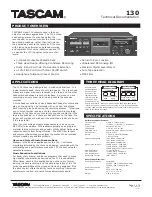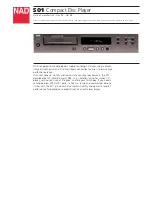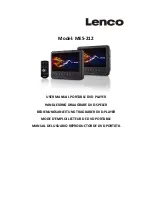
9
Getting Started
VQT8626
OPTICAL COAXIAL
SURROUND
SURROUND
CENTER
DIGITAL AUDIO OUT
(PCM/BITSTREAM)
SUB–
WOOFER
AC IN
R
R/
FRONT R
L/
FRONT L AUDIO OUT VIDEO OUT
S VIDEO OUT
AV1
AV2
L
L
R
AUDIO
IN
L
R
VIDEO
IN
S VIDEO
IN
Connection to a television
³
Ensure that this player and other equipment to be connected are switched to the standby mode or off and disconnect the AC mains lead before
commencing connection.
³
Do not block ventilation holes of any of the equipment and arrange them so that air can circulate freely.
³
Read through the instructions before connecting other equipment.
³
Ensure that you observe the colour coding when connecting audio and video cables.
³
See page 33 for information about how to upgrade your system with other audio/visual equipment.
Note
³
Additional equipment and cables are not supplied.
³
TV volume may be lower when playing DVDs than during television broadcasts. Turn the volume up while playing DVDs and reduce it to the
previous level before switching the source back to television to avoid sudden changes in volume.
³
When you have finished connection, select the appropriate screen type at the initial setting “6 TV Aspect” according to your television (4:3/16:9)
(
á
page 11). No changes are needed if you connect the player to a conventional television (4:3).
Conserving power
³
The unit consumes approximately 4.0 W even when it is turned off with [
ê
/I]. To save power when the unit is not to be used for a long time, unplug
it from the mains socket.
Connect Your Player Directly To Your
Television.
If the player is connected to the television through a video cas-
sette recorder, the picture may not be played back correctly due
to the copy guard. So we strongly recommend you do not con-
nect the player to your video cassette recorder when setting up
your home entertainment system.
³
Connect to the television section if you connect the player to a
combined television-video player.
Do not place the
player on amplifiers or
other equipment
which may become
hot.
The heat can damage the player.
Connecting to a television with video input terminal or S video input terminal
Note
³
If your television is monaural, use a stereo-monaural audio cable instead of the supplied audio/video cable. The video part of the cable (yellow)
can still be used if required.
To player audio output terminal (white, “L”)
To player audio output terminal (red, “R”)
Audio cable
To TV audio input terminal
Back of the player
To household mains
socket
(AC 220–240 V, 50 Hz)
Audio/video cable (supplied)
(See the note at the bottom of
this page.)
Television
AC mains lead
(supplied)
(The United Kingdom only)
BE SURE TO READ THE
CAUTION FOR THE AC
MAINS LEAD ON PAGE 4
BEFORE CONNECTION.
S video output terminal
The S (separate) video output terminal
achieves a clearer picture than the video
output terminal by separating the colour
(C) and luminance (Y) signals before
transmitting them to the television.
(Actual results depend on the television.)
S video cable
OR










































